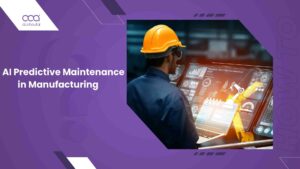Creating SEO content has transformed with the best AI writing tools, offering an innovative approach to crafting content that not only captivates the audience but also satisfies the intricate algorithms of search engines.
This guide will define you in detail how to create SEO content with AI writing tools. It navigates through identifying your audience and their queries, harnessing AI for keyword discovery, structuring your content with SEO in mind, and refining it to meet both user expectations and search engine standards.
So what are you waiting for? Find out more about creating the best SEO content with AI writing tools now.
How to Create SEO Content With AI Writing Tools? Step-By-Step Guide
Creating SEO content with AI writing tools can streamline and enhance the content creation process significantly. Here’s a refined step-by-step guide to effectively use AI for SEO content, followed by practical implications for each step.
Step 1: Define Your Content Goals and Target Audience
To begin, clearly define your objectives and understand your target audience’s needs and search intent, which are crucial in shaping the direction and tone of your SEO strategy. Utilizing an AI writing tool can further enhance this process, guiding you on how to create SEO content that resonates with your audience effectively.
Practical Implication:
When setting content goals in ChatGPT, I specified, “Develop a comprehensive guide for beginners on using SEO to boost website visibility.” This helps ChatGPT tailor the output to beginners interested in SEO, ensuring the content is relevant and accessible.
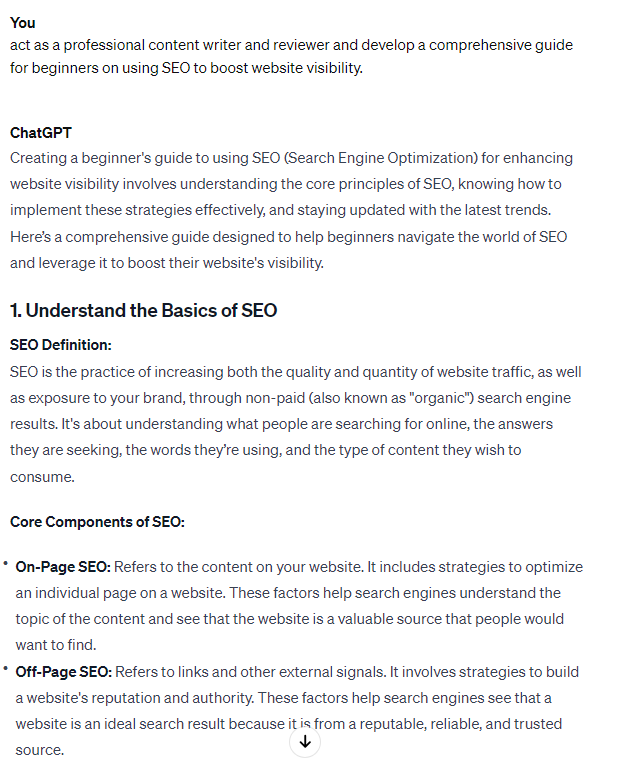
Step 2: Conduct Keyword Research
Use AI tools to identify keywords and phrases that your target audience is searching for. Focus on long-tail keywords, which are less competitive and more specific, to drive targeted traffic to your site.
Practical Implication:
Using ChatGPT, I prompted, “Identify long-tail keywords related to vegan baking recipes for beginners.” ChatGPT then provides a list of specific keywords, allowing me to create content that directly addresses the queries of my intended audience.
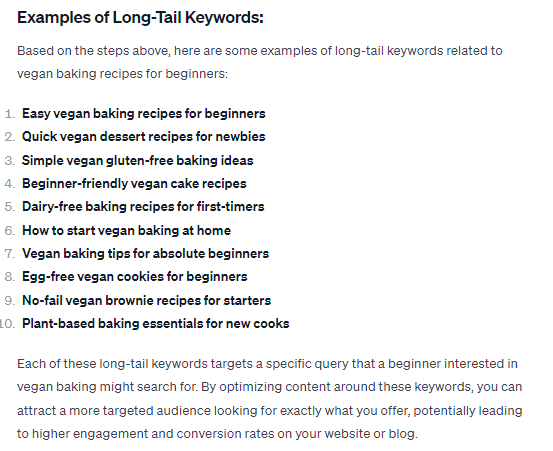
Step 3: Create a Content Outline
With your keywords identified, use AI to generate a content outline. This should include headings, subheadings, and a logical structure that covers the topic comprehensively, incorporating your keywords naturally. Whether you want to write SEO content for academics, medical, or for the fashion industry, AI tools can do it for you.
For those looking into integrating AI writing tools into academic research, there are tailored solutions that can enhance the research process significantly.
Practical Implication:
I instructed ChatGPT, “Create an outline for an article titled ‘Beginner’s Guide to Vegan Baking’ using identified keywords.” ChatGPT’s output serves as a structured guide, ensuring all key points and keywords are integrated.
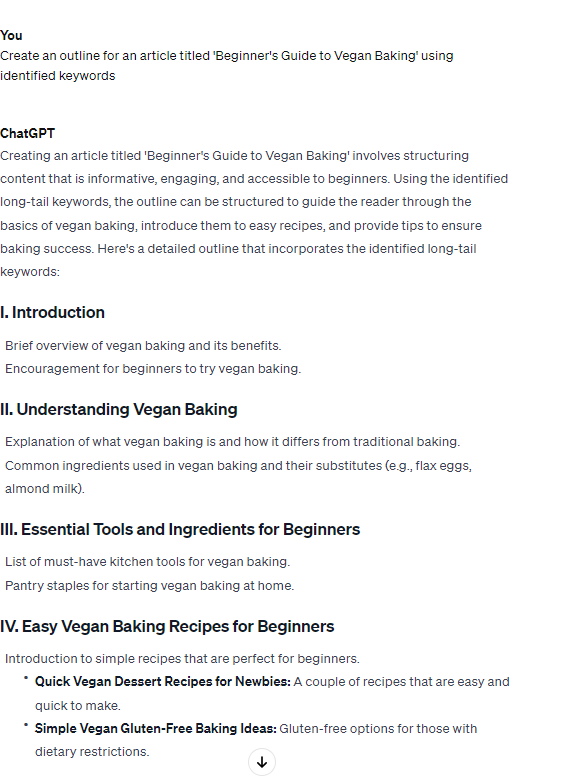
Step 4: Write the First Draft
To produce the first draft of your content, leverage the AI writing tool, ensuring it’s not only informative and engaging but also optimized for your content goals. This approach is crucial in understanding how to create SEO content with AI writing tools, making your work both appealing and search-engine friendly.
Practical Implication:
I prompted ChatGPT, “Write a comprehensive draft for ‘Beginner’s Guide to Vegan Baking’ using the provided outline.” This results in a well-structured first draft that incorporates SEO best practices and addresses the topic effectively.
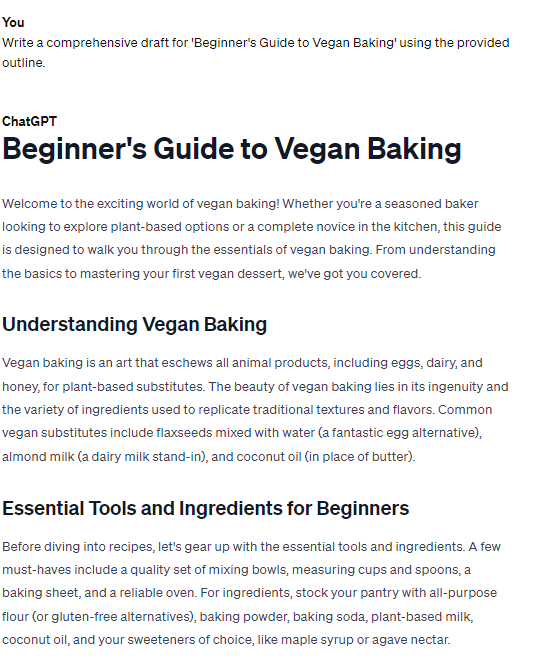
Step 5: Optimize for SEO
Refine your draft by optimizing it for SEO. This includes integrating keywords naturally, improving readability, and ensuring the content answers the audience’s questions. Use AI to suggest improvements and ensure compliance with SEO guidelines.
Practical Implication:
I asked ChatGPT, “Optimize the draft for SEO, focusing on readability and keyword integration.” ChatGPT then suggests enhancements that make the content more SEO-friendly without compromising its natural flow and readability.
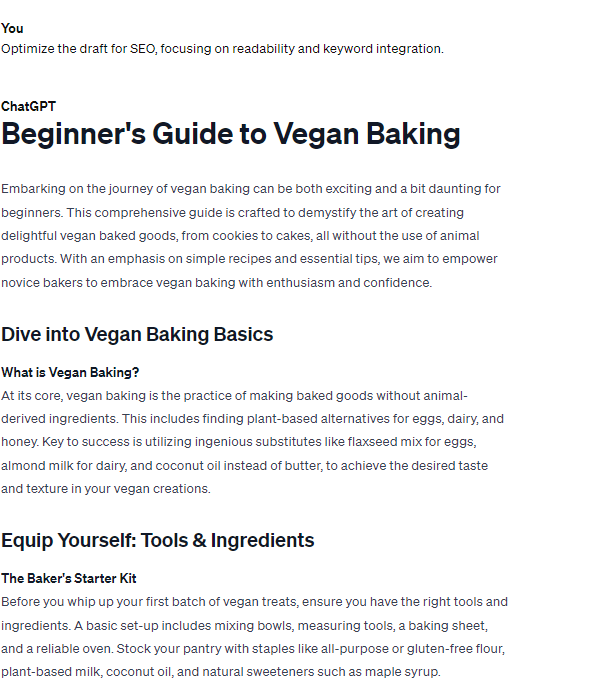
Step 6: Incorporate Visuals
Enhance your content with relevant visuals. Use AI tools to suggest or create images, infographics, and videos that complement your text. Visuals can improve engagement and provide a better user experience.
Practical Implication:
I prompted the ChatGPT, “Suggest appropriate visuals for ‘Beginner’s Guide to Vegan Baking’.” The AI generated images and infographics that illustrate key points, making the content more appealing and informative.
Step 7: Review and Edit
Perform a thorough review and edit of your content. Use AI to assist in identifying grammatical errors, ensuring factual accuracy, and enhancing the overall quality of the writing. A human touch is crucial in this final step to ensure the content resonates with the audience.
Additionally, it’s important to integrate practices for fact-checking AI-generated content to verify the accuracy and reliability of information, enhancing the trustworthiness of your content.
Practical Implication:
I commanded ChatGPT to “Conduct a final review of the draft for errors and improvements.” This step ensures the content is polished, accurate, and ready for publication, maintaining a high-quality standard.
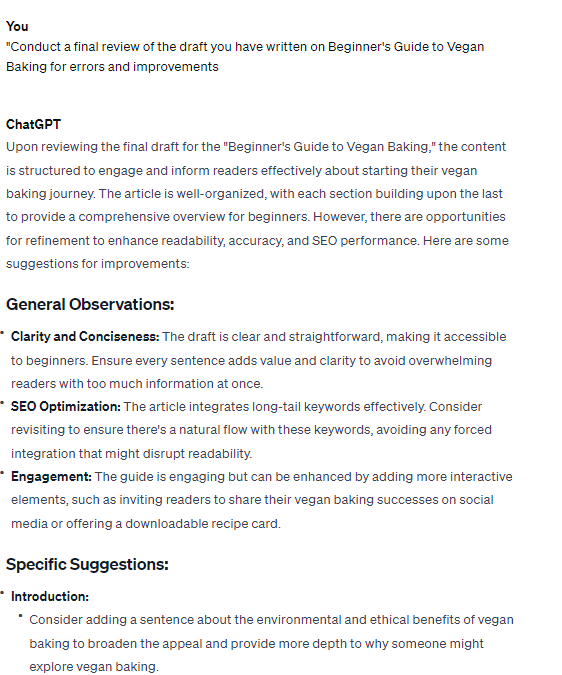
Step 8: Monitor and Update Content
After publishing, leverage AI writing tools designed for creating SEO content to monitor your content’s performance. Analyze traffic, engagement, and ranking data to pinpoint improvement areas. Continuous refinements using insights from tools like “How to Create SEO Content With AI Writing Tools” can ensure your content remains pertinent and ranks well.
Practical Implication:
Lastly, I asked ChatGPT, “Analyze performance data for ‘Beginner’s Guide to Vegan Baking’ and suggest updates.” This approach helps in refining the content over time, ensuring it continues to meet user needs and perform well in search results.

What is AI SEO?
AI SEO represents a futuristic approach to search engine optimization, harnessing artificial intelligence to refine and enhance strategies for boosting a website’s visibility. At its core, AI SEO involves utilizing AI technologies to optimize web content, making it more attractive to search engines.

- Automated Insights: AI can analyze vast amounts of data to identify SEO trends and opportunities.
- Content Optimization: Utilizes natural language processing to enhance content relevance for target keywords.
- User Experience Enhancement: AI improves website navigation and user engagement, signaling quality to search engines.
- Technical SEO: Automates the identification and correction of technical SEO issues.
AI SEO is defined by its ability to dynamically adapt strategies based on real-time data analysis, setting a new standard for optimizing web presence.
Advantages of Using AI SEO
Embracing AI for SEO tasks offers a multitude of benefits that can elevate the efficiency and effectiveness of digital marketing strategies:
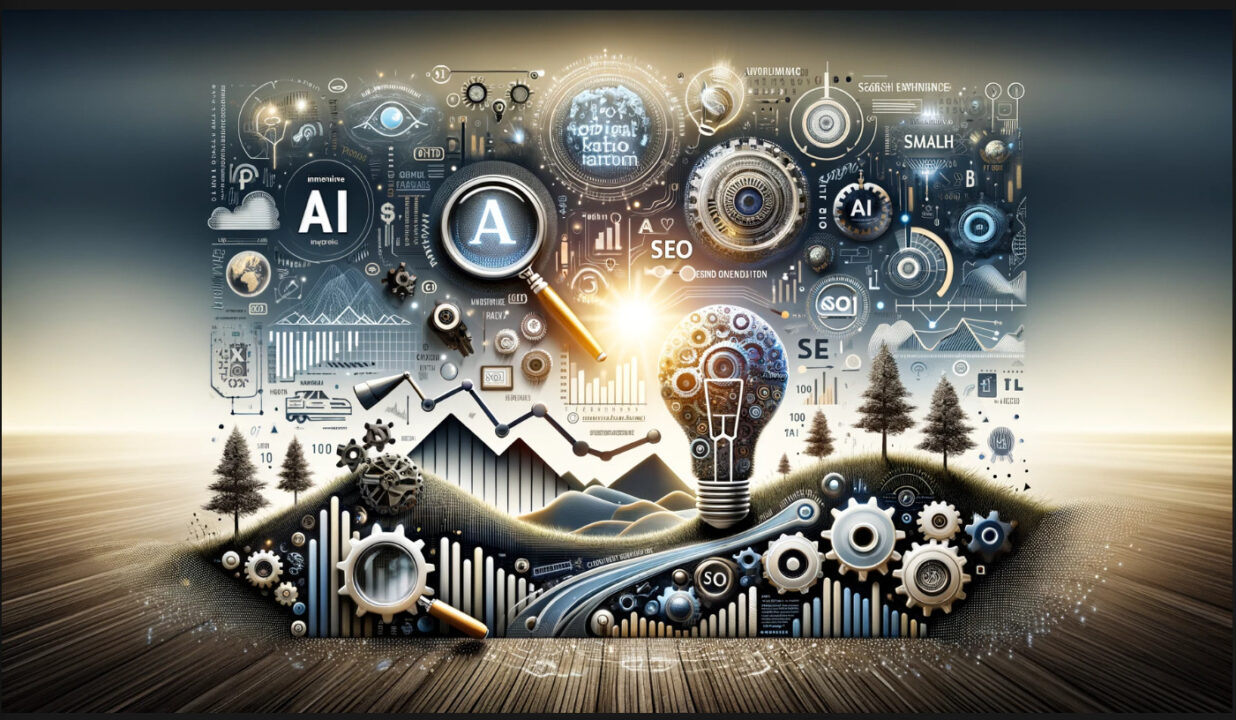
- Efficiency: AI tools streamline the SEO process, significantly reducing the time and resources required for tasks such as keyword research, content optimization, and performance tracking. This allows teams to focus on strategy and creativity.
- Precision: With advanced algorithms, AI provides targeted insights that enhance keyword selection, content strategies, and user engagement tactics, leading to more effective SEO outcomes.
- Adaptability: AI systems are designed to adjust to changes in search engine algorithms quickly, ensuring that SEO strategies remain effective over time without manual oversight.
- Personalization: AI can analyze user data to tailor content and experiences to individual preferences, improving engagement and conversion rates.
- Competitive Edge: Access to advanced analytics and predictive modeling gives businesses using AI for SEO a distinct advantage, enabling them to anticipate trends and adjust strategies proactively.
Disadvantages of Using AI SEO
Despite its advantages, the integration of AI into SEO strategies presents challenges that must be carefully managed:

- Complexity: The implementation and effective use of AI in SEO require a steep learning curve and an understanding of both the technology and the ever-evolving SEO landscape.
- Dependence: Overreliance on AI tools can lead to a lack of innovation and a decrease in the human creative input that is critical for engaging content creation.
- Cost: The initial setup and ongoing use of advanced AI SEO tools can be prohibitively expensive, particularly for smaller businesses or those just beginning to establish their online presence.
- Data Privacy: Utilizing AI in SEO often involves processing large amounts of user data, raising concerns about security, privacy, and compliance with data protection regulations.
- Algorithm Dependence: AI optimizations that focus too heavily on current search engine algorithms may risk the long-term effectiveness of SEO strategies, as these algorithms are subject to change.
How to Use AI Writing Tools For SEO Content
AI writing tools can revolutionize SEO content creation by enhancing efficiency and effectiveness:

- Streamline Research: Quickly gather and process vast amounts of SEO data, identifying trends, keywords, and opportunities with minimal effort.
- Content Creation: Produce initial drafts that are already optimized for SEO, allowing writers to focus on creativity and refinement.
- Enhance Readability: Automatically adjust content to improve readability and engagement, aligning with SEO best practices.
- Optimize for Keywords: Seamlessly integrate targeted keywords into content, ensuring natural inclusion that benefits both search rankings and reader experience.
- Monitor Performance: Employ AI tools to continuously analyze content performance, providing actionable insights for real-time adjustments and long-term strategy refinement.
Keyword Research
Effective keyword research is pivotal to SEO success, and AI significantly streamlines this process:

- Automated Analysis: Quickly identify high-potential keywords and phrases based on current trends and search data.
- Competitor Insights: Deeply analyze competitors’ strategies to uncover opportunities and gaps in keyword targeting.
- Search Intent Understanding: Employ AI to better interpret the intent behind searches, ensuring content aligns with user needs.
- Long-Tail Discovery: Discover valuable long-tail keywords that are often overlooked in manual research, offering niche targeting opportunities.
- Efficiency: Dramatically reduce the time required for keyword research, enabling faster strategy implementation and adaptation.
Link Building
AI enhances link-building efforts, a fundamental aspect of SEO, by providing speed and analytical depth:

- Opportunity Identification: Quickly locate high-quality link-building opportunities across the web.
- Relationship Management: Use AI to streamline the outreach and relationship-building process, improving efficiency and success rates.
- Link Health Monitoring: Continuously monitor the health and quality of backlinks, ensuring they contribute positively to SEO goals.
- Strategic Analysis: Gain insights into effective link-building strategies, including what types of links and sources offer the most value.
- Automation: Minimize manual efforts in link acquisition and management, allowing for a more strategic focus.
Content Generation
AI accelerates content creation, enabling a higher output of quality, SEO-optimized content:

- Rapid Drafting: Produce content drafts quickly, providing a strong foundation for further development and refinement.
- SEO Optimization: Ensure all content is optimized for search engines and user engagement from the outset.
- Content Scaling: Facilitate the production of a larger volume of content without sacrificing quality or relevance.
- Diverse Content Types: Support the creation of a wide range of content formats, from blog posts to videos, enhancing overall web presence.
- Consistency: Maintain a consistent tone of voice and brand message across all content, bolstered by AI’s understanding of brand guidelines.
Voice Search Optimization
As voice search becomes increasingly popular, optimizing content for this modality is essential:

- Natural Language Processing: Use AI to refine content, making it more conversational and aligned with voice search queries.
- FAQ Generation: Automatically create FAQ sections that directly answer common voice search queries, improving visibility and relevance.
- Local SEO Emphasis: Prioritize local SEO elements, crucial for capturing voice search queries with local intent.
- Device Compatibility: Ensure content is optimized for various voice search devices, from smartphones to smart speakers.
- User Intent Focus: Tailor content to the specific intents behind voice searches, enhancing the likelihood of matching user queries.
Prioritization with Analytics
Analytics-driven insights from AI tools enable effective prioritization of SEO efforts:

- Performance Analysis: Identify top-performing content to guide future strategy and focus areas.
- User Behavior Insights: Gain a deep understanding of how users interact with content, optimizing for engagement and conversion.
- Trend Spotting: Quickly adapt to emerging SEO trends, staying ahead of the curve.
- ROI Measurement: Assess the return on investment of various SEO strategies, focusing efforts on high-impact activities.
- Adjustment Recommendations: Receive data-backed suggestions for content and strategy adjustments, enhancing overall SEO performance.
How Does Google Feel About AI-Generated Content?
Google’s perspective on AI-generated content emphasizes the importance of quality, relevance, and adherence to guidelines:

Quality Over Quantity
To master how to create SEO content with AI writing tools, it’s essential to align with Google’s philosophy that prioritizes user value above all. These tools should be leveraged to produce content that addresses users’ queries with comprehensive, meaningful insights, rather than generating filler material.
Originality
The push for originality is a call to content creators to innovate and provide unique perspectives or insights. Google rewards content that brings something new to the table—be it through comprehensive analysis, fresh viewpoints, or novel information—not found elsewhere on the internet.
Transparency
Transparency about the use of AI in content creation builds trust with users and with Google. Disclosing the use of AI tools can help in setting the right expectations and demonstrates a commitment to honesty in content production.
User Focus
A user-centric approach is key to succeeding in Google’s search ecosystem. Content that prioritizes the needs, questions, and experiences of users above SEO manipulation or the pursuit of rankings is more likely to perform well.
Spam Detection
Google’s algorithms are increasingly sophisticated in identifying and penalizing content that tries to exploit SEO tactics without providing real value. This includes AI-generated content that is designed to rank well but fails to meet quality standards or serve the user’s interests.
Compliance with Guidelines
All content, regardless of how it’s generated, must adhere to Google’s Webmaster Guidelines, which emphasize the creation of user-friendly, accessible, and valuable content. Following these guidelines helps ensure that your content is seen as credible and trustworthy by Google, positively affecting its visibility in search results.
Ethical Considerations
Google underscores the importance of ethical content creation practices while using AI. This includes using AI responsibly to create content that is fair, unbiased, and does not mislead or deceive users.
FAQs
Here are some of the most commonly asked questions about how to create SEO content with AI writing tools.
Is AI content SEO-friendly?
Can SEO detect AI-generated content?
Can AI-written content rank on Google?
Will AI replace SEO content writers?
Conclusion
Leveraging AI writing tools for SEO content creation, such as learning how to create SEO content with AI writing tools, offers a blend of efficiency, precision, and adaptability, propelling digital marketing strategies into the future. While AI SEO presents certain challenges, its advantages significantly outweigh the drawbacks, making it an indispensable tool in the SEO arsenal. As the digital grounds continue to evolve, embracing AI in SEO practices will not only streamline operations but also ensure that content remains relevant, engaging, and, most importantly, visible in the ever-competitive search engine landscape.
For more insights and a comprehensive guide on using AI for writing SEO content, explore our how-to guides. Or you can enhance your understanding of our AI terms by visiting our AI glossary.


